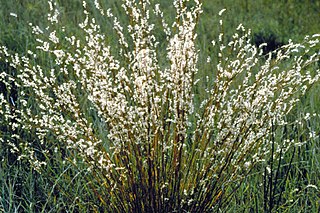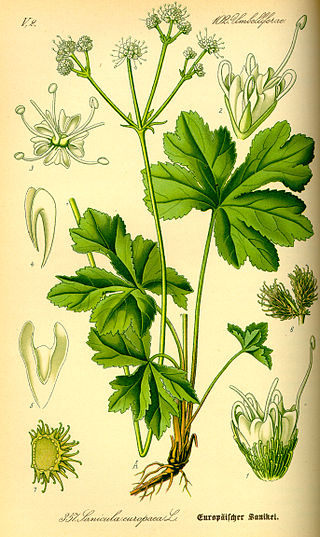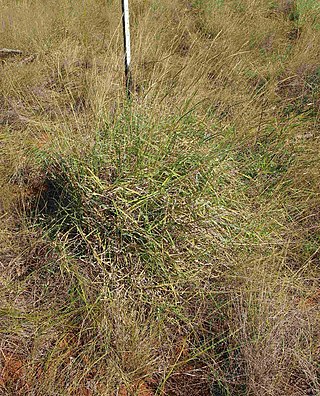
Penstemon, the beardtongues, is a large genus of roughly 280 species of flowering plants native to North America from northern Canada to Central America. It is the largest genus of flowering plants endemic to North America. As well as being the scientific name, penstemon is also widely used as a common name for all Penstemon species alongside beardtongues.

Saccharum is a genus of tall perennial plants of the broomsedge tribe within the grass family.

The Andropogoneae, sometimes called the sorghum tribe, are a large tribe of grasses (family Poaceae) with roughly 1,200 species in 90 genera, mainly distributed in tropical and subtropical areas. They include such important crops as maize (corn), sugarcane, and sorghum. All species in this tribe use C4 carbon fixation, which makes them competitive under warm, high-light conditions.

Panicum (panicgrass) is a large genus of about 450 species of Poaceae grasses native throughout the tropical regions of the world, with a few species extending into the northern temperate zone. They are often large, annual or perennial grasses, growing to 1–3 m (3–10 ft) tall.

Terminalia chebula, commonly known as black- or chebulic myrobalan, is a species of Terminalia, native to South Asia from Pakistan, India and Nepal east to southwest China (Yunnan), and south to Sri Lanka, Malaysia, and Vietnam.

Sanicula is a genus of plants in family Apiaceae, the same family to which the carrot and parsnip belong. This genus has about 45 species worldwide, with at least 22 in North America. The common names usually include the terms sanicle or black snakeroot.

Imperata is a small but widespread genus of tropical and subtropical grasses, commonly known as satintails.

Forsskaolea is a small genus of 7 species of perennial herbs in the nettle family with non-stinging hairs and dot-like concretions of mineral matter on their green parts. The genus was named in honor of Swedish botanist Peter Forsskål.
Tripidium arundinaceum, synonym Saccharum arundinaceum, commonly known as hardy sugar cane, is a grass native to tropical and subtropical Asia from India to Korea and New Guinea.

Urochloa, commonly known as signalgrass, is a genus of plants in the grass family, native to tropical and subtropical regions of Eurasia, Africa, Australia, the Americas, and various islands.

Mnesithea, or jointtail grass, is a genus of Asian, Australian, and Pacific Island plants in the grass family. The number of species placed in the genus varied considerably as of November 2024 depending in large part on how the genus Coelorachis was treated. Sources that synonymized Coelorachis with Mnesithea accepted about 26 species. Those that synonymized Coelorachis with Rottboellia accepted about seven.

Tripidium ravennae, synonym Saccharum ravennae, with the common names ravennagrass and elephant grass, is a species of grass in the genus Tripidium. It is native to Southern Europe, Western Asia and South Asia. It is known in North America as an introduced species, where it is sometimes an invasive and troublesome noxious weed.

Tripidium bengalense, synonym Saccharum bengalense, with the common names munj sweetcane, baruwa sugarcane or baruwa grass, is a plant of the genus Tripidium native to Iran, Afghanistan, Pakistan, Northern India, Nepal, Bangladesh and Myanmar.

Hellenia is a genus of plants in the Costaceae described as a genus with this name in 1791. It is native to Southeast Asia, southern China, the Indian Subcontinent, New Guinea, and Queensland. The type species was "H. grandiflora" Retz., which is a synonym of Hellenia speciosa.
Patzkea is a genus of plants in the grass family.

Stapfochloa is a genus of grasses. It is also in the subfamily Chloridoideae, and the Cynodonteae tribe.
Elizabeth Anne Kellogg is an American botanist who now works mainly on grasses and cereals, both wild and cultivated. She earned a Ph.D. from Harvard University in 1983, and was professor of Botanical Studies at the University of Missouri - St. Louis from September 1998 to December 2013. Since 2013 she has been part of the Kellogg Lab at the Donald Danforth Plant Science Center in Missouri, where she is principal investigator In 2020 she was elected a member of the National Academy of Sciences.
Tzveleviochloa is a genus of flowering plants belonging to the family Poaceae.
Quezeliantha is a monotypic genus of flowering plants belonging to the family Brassicaceae. It only contains one known species, Quezeliantha tibestica(H.Scholz) H.Scholz and has a synonym, QuezeliaH.Scholz.
Macrochloa is a genus of flowering plants belonging to the family Poaceae.














